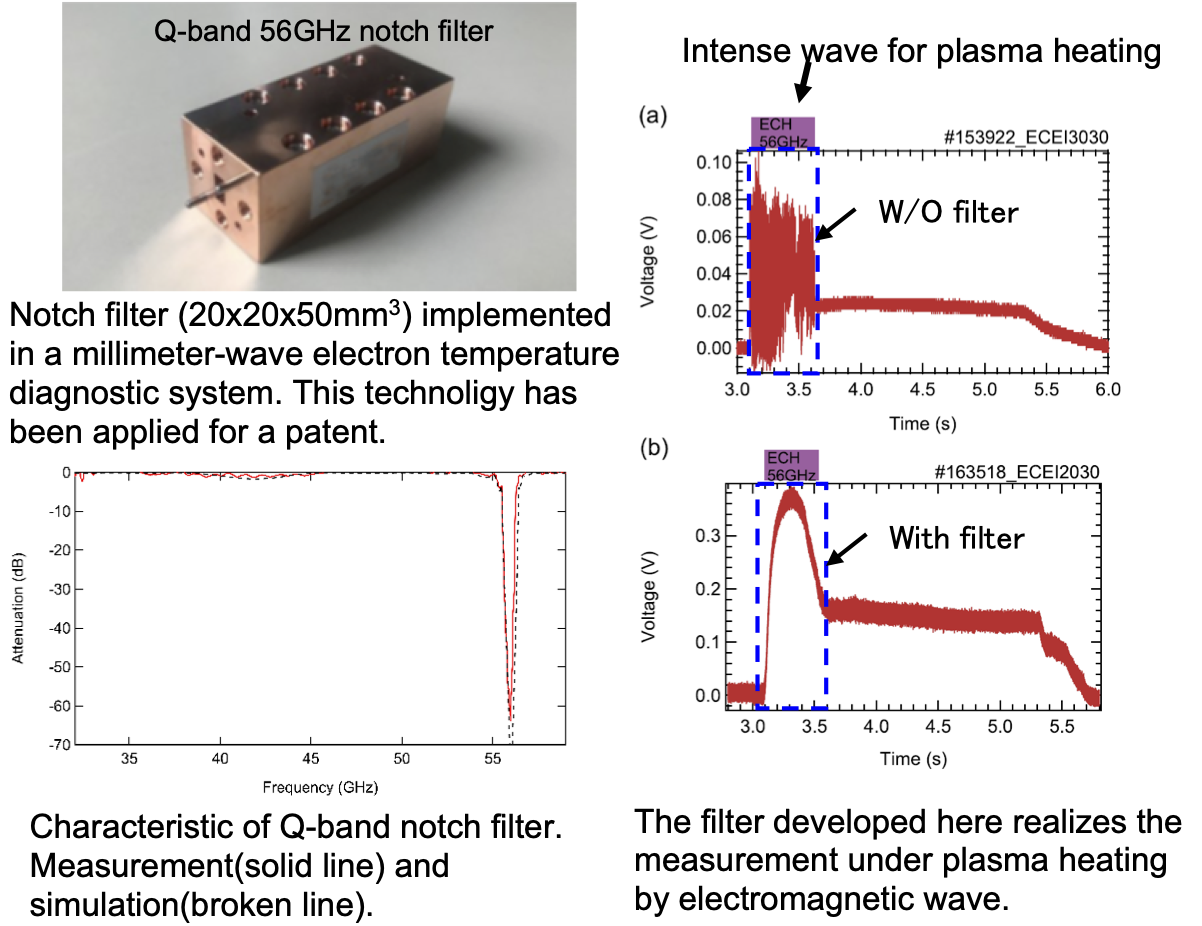Development of High-Performance Millimeter-Wave Filters for Diagnostics of Internal Structure of Ultra-High-Temperature Plasmas
In fusion reactors, millimeter-wave megawatt electromagnetic waves are used to heat the plasma to 100 million degrees Celsius, where the fusion reaction occurs. However, the powerful electromagnetic waves cause damage and noise to the plasma diagnostic system, making it difficult to measure the plasma correctly. To solve this problem, we developed a high-performance notch filter in the millimeter-wave band, which removes only specific frequencies for the millimeter-wave electron temperature diagnostic, and succeeded in measuring the electron temperature. This developed filter is one of the fundamental technologies required for plasma diagnostics using millimeter-waves and has a wide range of applications in industry, communications, and other fields.

In fusion reactors, millimeter-wave megawatt electromagnetic waves are used to heat the plasma to 100 million degrees Celsius, where a fusion reaction occurs. However, the powerful electromagnetic waves cause damage and noise to the plasma diagnostic system, making it difficult to measure the plasma correctly. To solve this problem, we developed a high-performance notch filter in the millimeter-wave band, which removes only specific frequencies for the millimeter-wave electron temperature diagnostic, and succeeded in measuring the electron temperature. This developed filter is one of the fundamental technologies required for plasma diagnostics using millimeter-waves and has a wide range of applications in industry, communications, and other fields.
In a fusion reactor, powerful electromagnetic waves are used to generate and maintain the high-temperature plasma. In the Large Helical Device (LHD), five gyrotrons capable of outputting 1-megawatt millimeter-wave electromagnetic waves (56 GHz, 77 GHz, and 154 GHz) are used for plasma generation and heating. On the other hand, millimeter-electromagnetic waves emitted from high-temperature plasmas contain information on electron temperature, which is an essential measurement for studying internal plasma dynamics. For this purpose, the electron cyclotron emission (ECE) diagnostic is used.
When millimeter-electromagnetic waves are used for heating in plasma measurement, the ECE diagnostic cannot correctly evaluate the electron temperature, due to the signal's noise. Since this noise can cause a failure of the measurement circuit in some cases, it was necessary to identify the cause and take countermeasures against it.
The research team found that millimeter-wave electromagnetic waves used for heating were interfering with the ECE diagnostic as noise. Therefore, they have developed a high-performance broadband notch filter (notch attenuation: 60 dB in frequency 56 GHz ±1.3 GHz) that removes the noise and allows the Q-band (33 - 50 GHz) to pass. They have also confirmed that the principle applies to frequency bands other than the Q-band. The filter's performance was optimized using a numerical model, and after fabrication and performance evaluation, the ECE diagnostic system implemented the filters. As a result, electron temperature measurement was realized under plasma heating, which had been difficult in the past.
To clarify the state of ultra-high temperature plasmas in fusion devices and control the burning, non-contact, and highly radiation-resistant instruments are required. The technology comes from the bulk and fast ion diagnostics, so-called collective Thomson scattering diagnostics. Therefore, the development of millimeter-wave tools and their use in plasma analysis is essential for burning fusion plasma research.
This research was published in Review of Scientific Instruments, a journal of the American Institute of Physics, on March 12, 2021.
